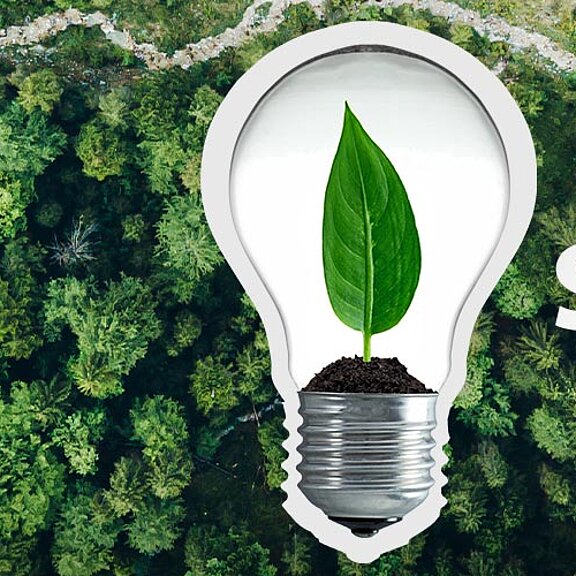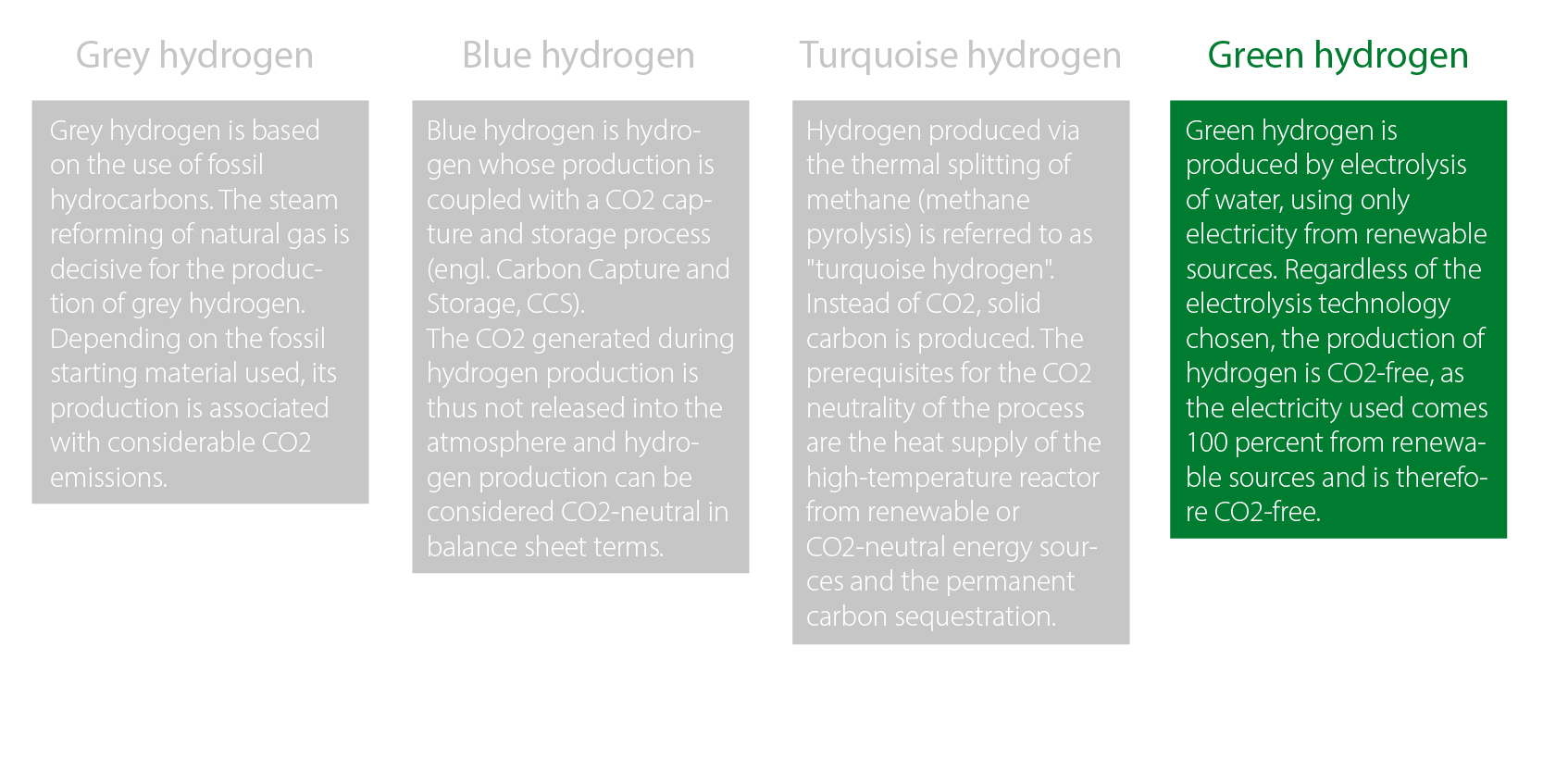

Suddenly everyone is talking about hydrogen! Why is that? What makes hydrogen so important in the energy revolution? And what does Bender have to do with it?
In a nutshell: hydrogen is an ideal storage medium for electrical energy and can be converted back into electrical energy with zero emissions. But as ideal as hydrogen is as an energy carrier and storage medium, the extraction and handling of this substance is anything but simple.
Hydrogen is actually a colourless gas. When people talk about green hydrogen, they mean hydrogen that is produced from green electricity, i.e. renewable energies. The production of green hydrogen therefore does not produce any climate-damaging gases such as methane or CO2 . That is why green hydrogen will become increasingly important in the future.
Continue to scroll if you want to read up on the subject more intensively. For those with little time, we have prepared a FAQ section.
Hydrogen is a chemical element. It comes first in the periodic table of the elements. Because hydrogen is the smallest and lightest chemical element there is. But did you know that hydrogen is also by far the most abundant chemical element in the entire universe? About 90 % of all matter in the universe consists of hydrogen. On earth, on the other hand, unbound hydrogen is very rare. The mass fraction of gaseous molecular hydrogen (H2) is only 0.9 %. The proportion of "bound" hydrogen (for example in the form of water = H2O), on the other hand, is much higher.
Even though hydrogen is the most abundant chemical element in the universe, it is not as easy to obtain as other substances in our world. This is for two reasons:
In some cases, very complex processes are needed to extract hydrogen from the starting materials. Many of them are not sustainable and climate neutral.
Hydrogen "burns" to water – without producing any other environmentally or climate-damaging by-products. Hydrogen is thus the ideal raw material for energy production. Hydrogen can also be used as an eco and climate-friendly fuel for cars, trains or aircrafts.

Since hydrogen is an ideal raw material for energy production and storage, it would be desirable to produce hydrogen in an equally eco and climate-friendly way. But that is easier said than done. Many processes for the production of hydrogen are costly, and some of them produce by-products that are harmful to the environment or the climate. Only the electrolysis process does not require any by-products.
In electrolysis, water is split into its two components hydrogen and oxygen by means of an electric current. But what if the electricity for electrolysis is generated from coal, oil or gas? Then hydrogen production is not climate-neutral. Only when electrolysis is set in motion by means of renewable energy can green hydrogen be obtained. Therefore, it will become increasingly important in the future to produce hydrogen using renewable energies.
Bender is already involved in several projects for the production of green hydrogen. For example, at the Mainz Energiepark. Approximately 200 t of hydrogen per year are produced there from surplus green electricity.
Energiepark Mainz operates 3 PEM electrolysers with peak outputs of 2 MW each. These electrolysers are supplied with a DC voltage of approx. 300-400 V. Very high currents flow during operation. As special safety requirements are placed on the electrical system due to the very high risk of explosion and the high currents that occur, the power supply to the electrolysers was designed as an unearthed network (IT system). In this way, unwanted leakage or fault currents can be detected more easily than in earthed networks. Bender insulation measuring devices (ISOMETER®) are used to monitor the electrical system. These detect abnormalities in the electrical system at an early stage and report them further. By detecting fault currents at an early stage, the electrolysers can be operated electrically safely. In this way, Bender helps to ensure that the electrolysis process can run reliably. With insulation monitoring, Bender thus has a direct influence on the efficiency of the entire system.
Bender is already involved in several projects for the production of green hydrogen. For example, at the Mainz Energiepark. Approximately 200 t of hydrogen per year are produced there from surplus green electricity.
Energiepark Mainz operates 3 PEM electrolysers with peak outputs of 2 MW each. These electrolysers are supplied with a DC voltage of approx. 300-400 V. Very high currents flow during operation. As special safety requirements are placed on the electrical system due to the very high risk of explosion and the high currents that occur, the power supply to the electrolysers was designed as an unearthed network (IT system). In this way, unwanted leakage or fault currents can be detected more easily than in earthed networks. Bender insulation measuring devices (ISOMETER®) are used to monitor the electrical system. These detect abnormalities in the electrical system at an early stage and report them further. By detecting fault currents at an early stage, the electrolysers can be operated electrically safely. In this way, Bender helps to ensure that the electrolysis process can run reliably. With insulation monitoring, Bender thus has a direct influence on the efficiency of the entire system.
Ammonia, fertiliser, petrol, water, sugar, yeast, alcohol and much more.
There is a lot of hydrogen in space. Hydrogen is not exactly rare on earth either. But terrestrial hydrogen is mostly "bound" (for example in water). Meaning: molecular hydrogen (H2) is rarely found in nature. It must therefore be extracted or dissolved from existing substances/compounds. There are different procedures for this. One of these is electrolysis. Here, water is split into its two components by an electric current.

Hydrogen can be produced in very different ways and from different starting materials. Many processes for producing hydrogen are not climate-neutral. Green hydrogen is obtained through the electrolysis of water. In this process, water is split into its two components, hydrogen and oxygen. The electricity required for electrolysis comes exclusively from renewable energy sources.
It is by far the "cleanest" hydrogen. This is because neither production through electrolysis nor the generation of the electricity required for this pollutes the environment with climate-damaging exhaust gases. Only electricity from renewable energy sources is used to produce green hydrogen.
On the one hand, the demand for hydrogen will increase in the coming years; on the other hand, the emission of climate-damaging gases during the production of H2 is to be reduced or even completely avoided. One goal of the national hydrogen strategy is therefore to produce about 14% of the expected 100 million. TWh H2, needed in Germany in 2030 from renewable energies.
Quite simple: Because the production is still significantly more expensive than with other processes.